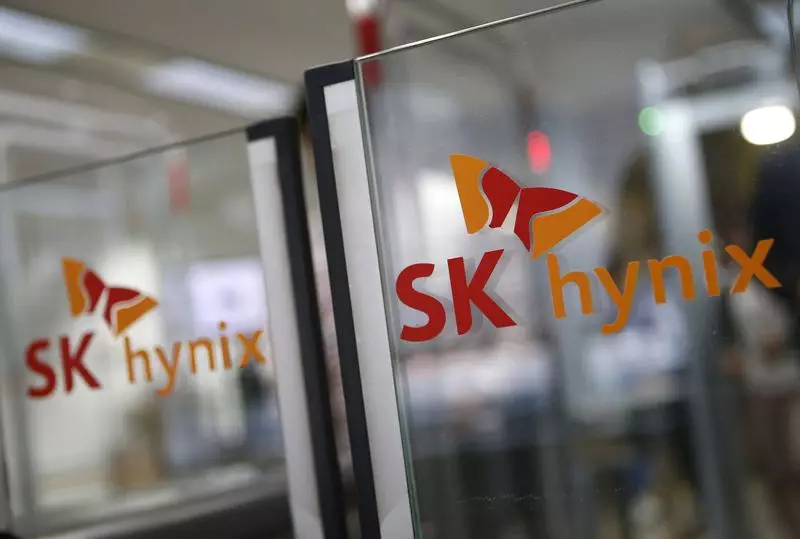In a rapidly evolving semiconductor market, SK Hynix has emerged as a significant player, especially in the realm of high-performance chips tailored for generative artificial intelligence (AI) applications. Recent reports highlighted a remarkable quarterly profit for the company, surpassing the achievements of its larger rival, Samsung. Such a feat not only underscores SK Hynix’s prowess but also reflects a burgeoning demand for high-end memory solutions driven by advancements in AI technology. However, the news wasn’t entirely optimistic, as shares of SK Hynix experienced a downturn amidst concerns about declining demand for traditional memory products.
For the fourth quarter, SK Hynix posted an impressive operating profit of 8.1 trillion won (approximately $5.64 billion), which marked a substantial increase compared to the previous year. This financial triumph was not only above market expectations but also positioned SK Hynix ahead of Samsung, whose profit forecast stood at 6.5 trillion won. This pivotal moment is seen as a turning point for SK Hynix, as it emphasizes the company’s growing dominance in the high-bandwidth memory (HBM) market – a segment attracting increased investment and attention due to its relevance in AI applications.
Despite the remarkable achievements, the leadership at SK Hynix expressed caution about the outlook for the memory chip industry moving forward. Economic uncertainty, coupled with fierce competition from Chinese manufacturers, could pose risks to sustained growth. The company’s Chief Financial Officer emphasized that while high-performance chip supply remains constrained due to escalating demand, declines in demand for older memory types could weigh heavily on future sales.
Considering the competitive landscape, analysts have begun recalibrating their growth projections for SK Hynix. Reports from financial experts indicated that the first quarter’s predictions fell short of earlier estimates due to anticipated declines in shipments of DRAM and NAND flash memory chips. Specifically, projections showed a potential downturn of 10% to 20% in ship quantities compared to the previous quarter. Observations by market experts like Lee Min-hee from BNK Investment & Securities reveal the underlying tension in SK Hynix’s ascent, as yesterday’s performance is juxtaposed against tomorrow’s uncertainties.
The share price fluctuations are indicative of a broader industry sentiment. After an initial surge of about 30% earlier in the year, driven in part by strategic discussions with AI powerhouse Nvidia, concerns over the sustainability of that growth hovered over SK Hynix. The interplay between burgeoning AI demand and the vulnerabilities in the commodity memory sector creates a precarious balance for investors and stakeholders alike.
The strategic direction that SK Hynix is taking involves a keen focus on capital expenditure, particularly regarding high-bandwidth memory development. Nonetheless, the company announced intentions to only modestly increase its capital expenditures for 2025, primarily channeling resources into HBM production and expansion of manufacturing capabilities within South Korea. This revelation has instigated apprehensions amongst analysts regarding the company’s capacity to maintain momentum amid deteriorating demand for legacy products.
Despite these reservations, the executive team at SK Hynix maintains an optimistic outlook on the long-term prospects of the AI industry and the essential role HBM chips play within it. With plans in motion to provide more advanced chipsets, like the anticipated 16-layer HBM4, SK Hynix has positioned itself to not only meet current demands but also adapt to evolving technological needs. Moreover, it aims to leverage market restrictions affecting Chinese competitors to solidify its leading position in the advanced memory sector.
The trajectory for SK Hynix encapsulates both a narrative of triumph and caution. While impressive quarterly profits and a surging demand for high-end semiconductors spotlight the company’s potential, underlying market dynamics present significant challenges. The company’s ability to effectively navigate decreasing demand for traditional memory products while bolstering its commitment to advanced memory development will be crucial in determining its future success. As SK Hynix continues to build on its foundational strengths, it must also remain vigilant about the rapidly shifting geopolitical landscape and competitive pressures that could reshape the semiconductor industry.

